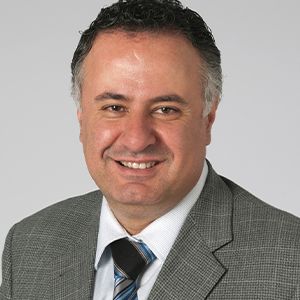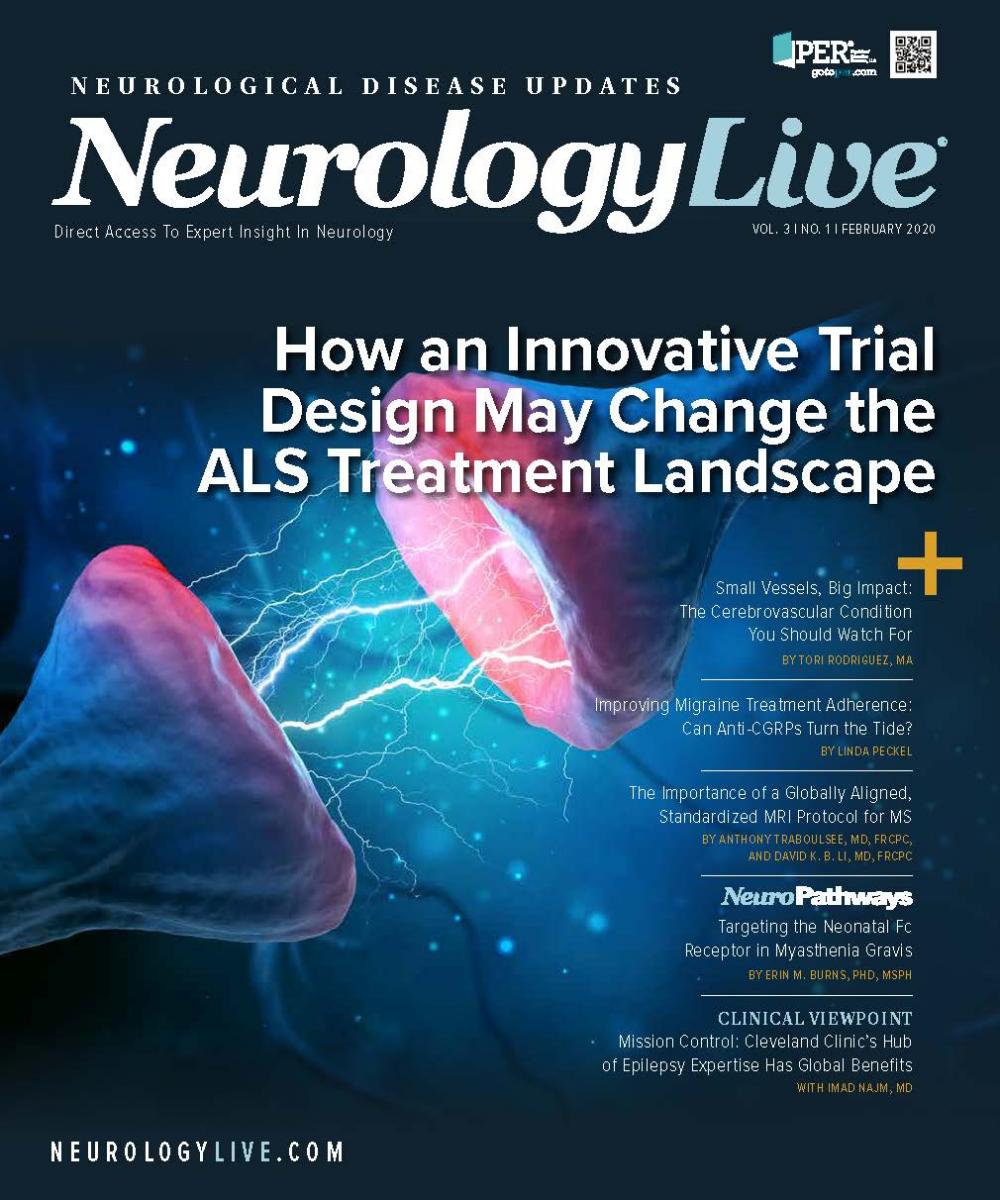Publication
Article
NeurologyLive
Mission Control: Cleveland Clinic's Hub of Epilepsy Expertise Has Global Benefits
Author(s):
Imad Najm, MD, director of the Cleveland Clinic Epilepsy Center, detailed the ongoing efforts to transform the way health care providers diagnose and treat patients with 1 ultimate goal in mind: improving access to high-quality care.

Imad Najm, MD
Tucked away behind an unassuming door in Cleveland Clinic’s Epilepsy Center sits a dozen or so technologists, their eyes trained on the 170 monitors that adorn the walls of the railroad car—shaped room like some sort of futuristic, digitized wallpaper. There, they intently watch live video footage and electroencephalogram (EEG) feeds of patients with epilepsy—some who are right down the hall and others who are on the other side of the world in Abu Dhabi.
This is the central monitoring unit (CMU), a mission control of sorts that allows patients with epilepsy to be cared for by Cleveland Clinic’s highly trained and specialized epilepsy team regardless of where they are physically located. The hospital’s technology-laden unit is just the latest iteration of the telemedicine evolution encompassing health care—a movement that Cleveland Clinic has long been at the forefront of.
In an interview with NeurologyLive®, Imad Najm, MD, director of the Cleveland Clinic Epilepsy Center, detailed the ongoing efforts to transform the way health care providers diagnose and treat patients with 1 ultimate goal in mind: improving access to high-quality care.
NeurologyLive: How has the use of telemedicine evolved over the years at the Cleveland Clinic Epilepsy Center?
Imad Najm, MD: Telemedicine has existed since digitization started in the medical field, and it has evolved over the years with our ability to connect better. Back at Cleveland Clinic in 1989, we were among the first in the world to take the EEG recording from ink and paper and create one of the first digital EEG systems. That was, to me, the first entry into what is now modern telemedicine because this allowed us to watch the patient from a distance, and that distance was basically dependent on the connectivity between the patient’s room and the place where the technician was watching the patient.
The second big step we took in telemedicine proper was in 2010. We had more patients who needed to be monitored and more who needed to be monitored close to home while we continued to provide the highest level of care. We faced 2 choices: continue what we were doing and open a new epilepsy monitoring unit wherever we needed one with full staffing, or use technology to connect these settings and these machines wherever they are in the world to a single area where we can have a group of highly trained, highly experienced individuals with excellent expertise in the field to monitor more patients from the same setting 24 hours a day, 7 days a week, 365 days a year. This is when we started the concept of the CMU. This evolved over the years, from monitoring patients on various floors within Cleveland Clinic, to monitoring patients at our Florida campus, regional hospitals here in Cleveland and Akron, and then Cleveland Clinic Abu Dhabi in the United Arab Emirates. Now we’re able to monitor anywhere between 50 and 80 patients at the same time, in various locations around the country and world. In 2021, we plan to expand this to Cleveland Clinic London, as well. We have created an environment where we can do EEG studies and monitor the patient live from wherever they are, we can read the EEG, and we can provide immediate feedback to the local units.
All along, we have been monitoring this through various metrics, the most important of which is how many of these seizures are identified? How fast are we identifying the seizure? And how fast are we adjusting our nursing teams—wherever they are—next to the patient? We are reaching 98% to 99% live seizure detection. This is a major milestone because we are stopping [antiseizure] medications in these patients [in the epilepsy monitoring unit], and there is, of course, a risk of seizures, but even worse, risk of status epilepticus. If that happens, we need to intervene very fast, so it is essential to detect the seizure. Using this digital platform that we adopted in 2010, we are able to not only reach out to patients wherever they are, we are able to provide them with the acute care that is of the highest standard that we are asking all of our sister hospitals to achieve.
How have you incorporated this technology inside Cleveland Clinic to benefit those patients under your direct care, as well as the physicians in the broader Cleveland Clinic network?
The new M80 unit that we opened in conjunction with our stroke colleagues takes input and intervention to a new level. In this unit, a physician or epileptologist has access to the patient in their hospital room at any time, face to face, via a screen. We can interact with the patient, do the exam through a nurse or an advanced practice provider, and then basically be able to intervene any time of the day should the patient need help. We are utilizing this technology not only to read the EEG studies and participate in discussion about a patient but also to put the physician next to the patient whenever the patient needs to be seen or to be taken care of.
At the same time, we took the concept of telemedicine to another level by expanding it to physician-to-physician discussion. There is a need for a high level of expertise in the field, but it is very difficult to start a program for example, in Florida, and within the first year or 2 or even 5 or 10 years, to have 21 epileptologists like we have here [in Cleveland] who are highly trained, highly experienced, and assemble them together in a single setting to discuss a particular case. Now, we have our colleagues in Abu Dhabi and Florida present their cases live via video to our multidisciplinary team in Cleveland. Our team listens, interacts, and contributes opinions on what we think about the case and those physicians will take those opinions and use them to help decide what they will recommend for the patient.
The CMU is the heart of this digital platform, and it operates 365 days a year. At any time of the day, any day of the year, you’re going to have a full team monitoring these patients. The new unit has basically taken the monitoring from being passive to active. We are allowing the physician to be present virtually through the platform any time there is a need, whether to guide the treating team or to alleviate anxiety of the patient or the family. This is where we close the circle. We are not only monitoring, we are not only giving feed- back, we are there whenever the patient needs us or when the situation arises when a physician’s input is needed.
Implementing this technology is a major investment. What makes it worthwhile, and why is this the direction we should be going in patient care?
We all aim and work every day to provide the best quality of care for our patients. In order to accomplish this, we have 2 options. The first option is to make sure we have the greatest team of experts close to every patient wherever the patient is. This is extremely difficult, and from a staffing standpoint, almost impossible, and it would be prohibitive from a cost perspective to recruit these people and to have them on the ground and with the infrastructure to do it. The second option is basically to centralize the expertise but make this expertise available wherever there is a need. From a business standpoint, the hospital will be able to reach out to many more patients than they would have if they went with option 1. We have to provide some upfront investment, but this investment is much less than it would have taken the same hospital system to staff one of their community hospitals independently.
With the system, a single hospital or a single [source of ] expertise can reach out to places that otherwise would have been deprived of the services, or the services would have been prohibitively more expensive to provide and therefore, they would not be able to survive the realities of reimbursement in health care. In a time where our insurers and our government agencies are trying to save money, we cannot continue to use the same model of care where everything is decentralized. We have to get things together to provide centralized care with the highest quality, otherwise we cannot survive. It’s not about surviving as health care providers, it is about access to care, which is a big problem now and is going to be a bigger problem in the future. Access to care cannot be afforded unless we use tech- nology to make sure the highest expertise, the places where they have reached critical mass, so to say, are able to provide these services and reach out to a bigger number of patients in locations that are not in proximity or not contiguous to where the expertise is.
With so much potential growth in this realm, what are your hopes for the future?
I think we are just scratching the surface of how we can use technology to improve patient care. I think what is next is to take the expertise, but more importantly take the experience of groups like ours and other groups in the country with a huge amount of data on patients and on the disease that we treat and take it to the next level by using artificial intelligence (AI) and machine learning to be able to provide an even higher level of service and a much more scalable level of service to patients in any location.
The next frontier is taking the expertise and data and incorporating them into algorithms that will help us elevate the diagnostic and ther- apeutic interventions and yield to a completely different level. At the epilepsy center, we are starting to use AI in select areas and I would say in maybe the next 2 to 3 years, we will be fully using AI to complement what we’re doing now and elevate it to an even higher level of care and much more consistent level of care than what we have now.
Transcript edited for clarity.





